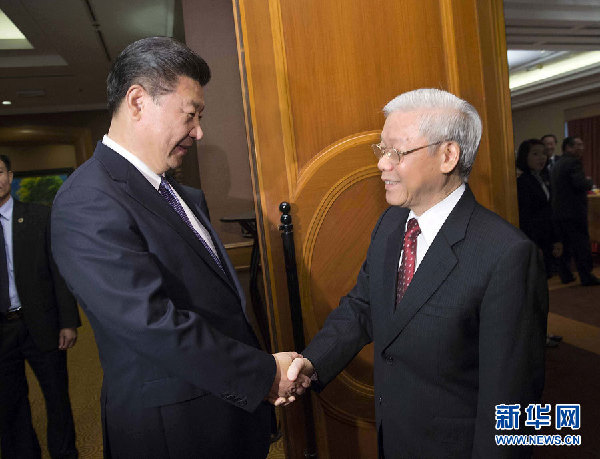By Gu Jianjun, post doctorate of Central Compilation and Translation Bureau
Chinese President Xi Jinping paid a state visit to Vietnam, Nov 5-6 at the invitation of Vietnam's Communist Party Chief Nguyen Phu Trong and President Truong Tan Sang, the first by China's top leader in over a decade. Xi's visit would strengthen party relations and political mutual trust, while promoting economic-trade cooperation and cultural exchanges.

Chinese President Xi Jinping (L) meets with General Secretary of the Communist Party of Vietnam Central Committee Nguyen Phu Trong in Hanoi, Vietnam, Nov. 6, 2015.
Traditional brotherly friendship
China and Vietnam are neighbors and socialist countries led by the Communist Party. Their friendship was formed and cultivated by Mao Zedong, Ho Chi Minh and other leaders of the older generation.
Since the establishment of diplomatic ties in 1950, the bilateral relations have maintained strong growth momentum as they formed a comprehensive strategic partnership in 2008. In April and September this year, Xi met Vietnam's Communist Party Chief Nguyen Phu Trong and President Truong Tan Sang in Beijing, to consolidate improved bilateral relations.
During Xi's visit, he held talks with Vietnamese leaders, including Communist Party Chief Nguyen Phu Trong , President Truong Tan Sang, Premier Nguyen Tan Dung, Chairman of National Assembly Nguyen Sinh Hung and others, exchanging views on issues of common concern.
Xi also met with Vietnam’s youth delegation, visited the Memorial Hall of Ho Chi Minh and addressed the Vietnamese Parliament to expound on China-Vietnam relations.
The two sides agreed to adhere to long-term stability, look to the future for comprehensive cooperation, as well as enhance the spirit of good neighbors, good friends, good comrades and good partners in a sustained and healthy manner.
Integrating development for win-win results
China has been Vietnam's largest trade partner for eleven years. In 2014, bilateral volume of foreign trade reached 83.6 billion US dollars. In the first three quarters this year, trade volume stood at 64.1 billion US dollars, 12 percent a year-on year growth. Bilateral trade volume could exceed 90 billion US dollars this year.
Xi aims to integrate China's "Belt and Road" initiative and Vietnam's "Two Corridors and One Economic Circle" plan, deepening production capacity cooperation for win-win results.
The "Two Corridors and One Economic Circle" plan refers to the "Kunming-Lao Cai-Hanoi-Haiphong" corridor, "Nanning-Lang Son-Hanoi-Haiphong" corridor and "Beibu Gulf Rim Economic Circle". In 2004, the Vietnamese leader visited China and proposed construction of the "Two Corridors and One Economic Circle" plan, which was endorsed by Beijing.
Control maritime differences for stable South China Sea
Beijing and Hanoi should resolve challenges, especially in regards to maritime differences and dispel confrontation through friendly negotiations.
Both sides seek a consensus to boost maritime joint development projects, strengthen cooperation in low-sensitive areas, and advance negotiations on the demarcation of territorial waters outside the Beibu Gulf estuary, which has an iconic meaning to resolve the South China Sea dispute through peaceful cooperation.
Additionally, cooperation documents in terms of infrastructure construction, economic and trade investment, cultural education and more were signed, laying the foundation for exchanges to enter a new stage for the advancement of regional peace and prosperity.
( The opinions expressed here do not necessarily reflect the opinions of Panview or CCTV.com.)